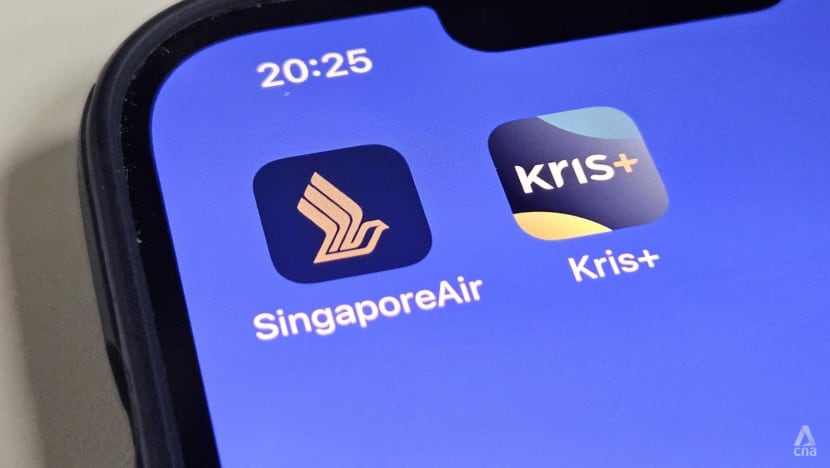Commentary: SIA is introducing dynamic pricing to KrisFlyer. Should members be worried?
Airlines say dynamic award pricing will offer greater flexibility for frequent flyers. History has shown that customers will be on the losing end, says The MileLion’s Aaron Wong.

The SingaporeAir and Kris+ apps, which use KrisFlyer miles, are displayed on a mobile phone on May 28, 2025. (Photo: CNA)

This audio is generated by an AI tool.
SINGAPORE: When Singapore Airlines announced that changes were coming to its KrisFlyer frequent flyer programme, effective from Nov 1, most of the attention was on the increase in miles required for redeeming flights or upgrading seats.
But buried in the same announcement was something that could prove far more consequential in the long run: the introduction of Access awards.
Unlike KrisFlyer’s Saver and Advantage awards, where prices are fixed based on an award chart, Access awards are dynamically priced. This means that the mileage required will vary based on factors such as seat demand, route popularity, and seasonality.
SIA is positioning Access awards as a way for KrisFlyer members to secure redemption seats even when Saver and Advantage awards are unavailable. It has also emphasised that Access awards will be offered on top of existing Saver and Advantage awards.
But like many frequent flyers, I had a sinking feeling when I read the news. Regardless of how airlines may spin it, experience has shown that dynamic pricing is rarely good news for customers.
NOT A NEW CONCEPT
While SIA would be one of the first major carriers in Asia to introduce dynamic award pricing, the concept is far from new.
Delta SkyMiles eliminated award charts in favour of dynamic pricing in 2015, and many others have since followed to varying degrees, including United MileagePlus, Air France-KLM Flying Blue, Virgin Atlantic Flying Club, Air Canada Aeroplan and Lufthansa Miles & More.
In each case, the narrative was that dynamic pricing would benefit customers by offering greater seat availability, increased flexibility, no blackout dates, and reduced complexity. What really happened, however, was something else entirely.
LOSS OF PRICING TRANSPARENCY
For frequent flyers, one of the biggest frustrations with dynamic pricing is the lack of transparency.
With a published chart, members know exactly what to expect. With dynamic pricing, the cost of award flights is opaque. The airline is hardly going to release the formula they use to calculate prices, or inform you when they tweak it.
Therefore, dynamic pricing can be carte blanche for unannounced devaluations, where redemption prices are furtively hiked overnight. What’s the price of an award? It’s whatever the airline says it is.
For members, this creates uncertainty. Should you save miles for a future trip, or redeem them now before prices spike? Travellers may choose to cash out quickly or avoid hoarding miles altogether, preferring instead to hold flexible credit card points that can be transferred to multiple programmes. This shift weakens the long-term loyalty airlines are trying to build.
OPPORTUNITIES FOR OUTSIZE VALUE ARE REMOVED
The fixed prices offered by award charts have the potential to create “sweet spots”, redemptions where the mileage requirement is disproportionately low to the cash fare.
For example, one of the best-value KrisFlyer awards is a Business Class ticket from Singapore to Cape Town, a 13-hour flight which costs just 56,500 miles each way. That same flight could cost more than S$4,000 if purchased with cash.
Dynamic pricing eliminates these opportunities because mileage requirements now track cash fares much more closely. It limits the ability of savvy members to obtain outsize value for their miles, and if taken to the extreme, can turn a frequent flyer programme into a glorified cashback scheme, with no real way to come out on top.
While airlines claim that dynamic pricing results in greater award seat availability, the simple truth is that many of these seats are offered at such astronomical prices that they may as well not exist.
For example, with Delta SkyMiles, it’s not uncommon to see one-way Business Class awards between the US and Europe exceeding 300,000 miles, many times what you would pay through alternative programmes with award charts.
With Air France-KLM Flying Blue, Business Class seats between Singapore and Europe can be a reasonable 85,000 miles at times, but are more often in the range of 200,000 to 400,000 miles when dynamic pricing is given free rein.
What’s more, it can feel like airlines with dynamic award pricing are trying to have their cake and eat it. When cash fares rise, so too does the cost of awards. When cash fares fall, preset floor prices limit the upside for members.
PAST LOYALTY IS DISCOUNTED
Loyalty programmes make the grind of travel more bearable. No one relishes the prospect of squeezing into an economy class seat, but the consolation is that if you do this frequently enough, eventually you’ll be able to upgrade to business class.
But dynamic pricing breaks that promise. When award prices become unpredictable, it feels like the goalposts are shifting all the time. Frequent flyer miles are earned slowly over the years – often at personal expense or inconvenience – by staying within the airline’s ecosystem. If there’s no guarantee this loyalty will be recognised, what incentive is there to keep at it?
Singapore Airlines has not provided any indicative pricing for Access awards, so the jury is out until at least Nov 1.
On paper, if Access awards do not cannibalise existing Advantage and Saver award space, then having more options never hurt anyone. And while I’m quite certain that Access awards will be largely unattainable to the average member, those with sizeable KrisFlyer balances may appreciate the extra availability – even if it comes at a steep price.
The problem is that we’ve seen this playbook before. Dynamic pricing is initially introduced on a limited scale and framed as a benefit that gives members more choice. But over time, it starts to proliferate throughout the programme, increasing prices, erasing sweet spots, and eventually replacing award charts altogether.
The impact may not be limited to just SIA. Competitors are no doubt watching closely, and this could pave the way for other airlines in the region to start implementing dynamic award pricing of their own.
Access awards may sound innocuous now, but don’t be surprised if they end up costing everyone more in the long run.
Aaron Wong is the founder of travel website The MileLion.

















